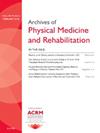Impact of Accompaniment Music on Rehabilitation Compliance and Performance During Music-based Training in Stroke 8252
IF 3.6
2区 医学
Q1 REHABILITATION
Archives of physical medicine and rehabilitation
Pub Date : 2025-04-01
DOI:10.1016/j.apmr.2025.01.039
引用次数: 0
Abstract
Objectives
To investigate the impact of accompaniment music on patient compliance and performance during a 2-week in-home upper extremity music-based training (MBT) in stroke survivors.
Design
This is a within-subject feasibility study to understand how music influences participants’ engagement and performance during home training.
Setting
Participants’ home.
Participants
Community-dwelling individuals with chronic stroke and mild to moderate hemiplegia.
Interventions
During the 2-week MBT, participants were asked to exercise their upper extremities for at least 1 h/d with a piano keyboard and an iPad installed with a stroke-specific MBT app. The MBT included 2 training modes, nonmusic versus music, which were switched alternatively throughout the 2 weeks. Under the nonmusic mode, participants’ keystrokes were visually cued although they could hear the musical notes that they played on the keyboard. Under the music mode, accompaniment music with a steady pulse and visual guides cued key presses.
Main Outcome Measures
The app usage time (total and daily) and keynote press accuracy were measured to understand participants’ training compliance and performance, respectively. We compared the results between the 2 different modes to explore the impact of the accompaniment music on stroke survivors.
Results
We recruited 5 stroke survivors and observed the average total usage of 131 minutes for nonmusic mode and 142 minutes for music mode across all the participants. The average daily app usages were 22.9 min/d and 26.56 min/d under nonmusic and music modes, respectively. We also observed a difference in keynote press accuracy between the nonmusic mode (averaged 0.115s delay) and the music mode (averaged 0.097s delay).
Conclusions
Our preliminary results showed that stroke participants had greater use of the MBT app for rehab exercises under the music mode than the nonmusic mode. Participants’ keynote press accuracy was also more precise when they could hear the accompaniment music. These findings suggest that accompaniment music may play an important role in affecting not only participants’ engagement but also their performance. Data collection will be continued to demonstrate a robust result and explore the potential explanations for the observed differences.
Disclosures
none.
音乐训练对脑卒中患者康复依从性及表现的影响[j]
目的探讨在为期2周的脑卒中幸存者家庭上肢音乐训练(MBT)中,伴奏音乐对患者依从性和表现的影响。这是一项主题内可行性研究,旨在了解音乐如何影响参与者在家庭训练期间的参与和表现。SettingParticipants”回家。参与者:居住在社区的慢性脑卒中和轻度至中度偏瘫患者。干预措施在为期两周的MBT中,参与者被要求使用钢琴键盘和安装了针对中风的MBT应用程序的iPad锻炼上肢至少1小时/天。MBT包括两种训练模式,非音乐和音乐,在两周内交替切换。在非音乐模式下,尽管参与者可以听到他们在键盘上弹奏的音符,但他们的击键是视觉提示的。在音乐模式下,伴奏音乐具有稳定的脉冲和视觉引导提示按键。主要结果测量分别测量应用程序使用时间(总和每日)和主题新闻准确性,以了解参与者的培训依从性和表现。我们比较两种不同模式的结果,探讨伴奏音乐对脑卒中幸存者的影响。结果我们招募了5名中风幸存者,观察了所有参与者在非音乐模式下的平均总使用时间为131分钟,在音乐模式下的平均总使用时间为142分钟。在非音乐和音乐模式下,平均每日应用使用时间分别为22.9分钟/天和26.56分钟/天。我们还观察到,在非音乐模式(平均延迟0.115秒)和音乐模式(平均延迟0.097秒)之间,基调按压的准确性存在差异。结论初步结果显示,卒中参与者在音乐模式下使用MBT应用程序进行康复训练的比例高于非音乐模式。当参与者听到伴奏音乐时,他们对主题新闻的准确性也更准确。这些发现表明,伴奏音乐可能在影响参与者的参与和他们的表现方面发挥重要作用。将继续收集数据,以证明一个可靠的结果,并探索观察到的差异的潜在解释。
本文章由计算机程序翻译,如有差异,请以英文原文为准。
求助全文
约1分钟内获得全文
求助全文
来源期刊
CiteScore
6.20
自引率
4.70%
发文量
495
审稿时长
38 days
期刊介绍:
The Archives of Physical Medicine and Rehabilitation publishes original, peer-reviewed research and clinical reports on important trends and developments in physical medicine and rehabilitation and related fields. This international journal brings researchers and clinicians authoritative information on the therapeutic utilization of physical, behavioral and pharmaceutical agents in providing comprehensive care for individuals with chronic illness and disabilities.
Archives began publication in 1920, publishes monthly, and is the official journal of the American Congress of Rehabilitation Medicine. Its papers are cited more often than any other rehabilitation journal.

 求助内容:
求助内容: 应助结果提醒方式:
应助结果提醒方式:


